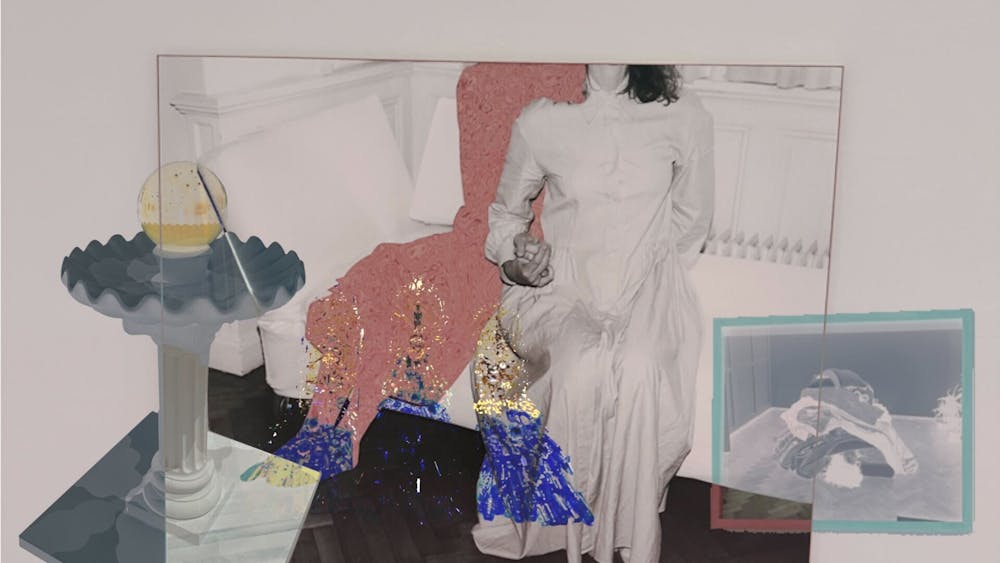Walking into the Institute of Contemporary Art on Penn’s campus, the inaugural work of the Entryways project greets you: Nontsikelelo Mutiti’s cut–vinyl depiction of ironwork and braided hair calls upon African craftsmanship and memories of the design and textures that have guarded her life. The curling imagery pays homage to the protective hairstyles and gates found in African communities around the globe: particularly, Mutiti’s motherland of Zimbabwe and neighborhoods in Brooklyn. The ornate visage adds to the otherwise flat, modernist architecture of the building.
Entryways: Nontsikelelo Mutiti is one of three exhibitions on display this fall at the ICA. All of the installations take a look at intergenerational tradition, vulnerable performance, and the built environment of our homes.
Where I Learned To Look: Art From the Yard, curated by artist and art historian Josh Franco and organized by two ICA curators, Hallie Ringle and Denise Ryner, is the exhibition on the ground floor. Placed as though it were a front yard of a home, the exhibition sees Franco examine the practically quirky, adoringly sentimental, and handmade work of yard art. Within a collection of over 30 works by varying artists, paintings, videos, sculpture, and assemblage represent the yard, a space which Franco describes on the wall text as “a patch of grass, a strip of sidewalk, a fencepost, the open woods, or even a notebook” and a transition “between the home and wider world.”

Yard art typically exists outside of traditional gallery spaces in museums as lawn ornaments, garden sculptures, or topiary shrubs, but Art from the Yard conceptualizes the yard as a much more abstract respite between interior and exterior. Franco lugs the painted snakes, rusted metal works, and implanted foliage inside gallery walls, exhibiting an American tradition of yard space and domestic decoration that began in the postwar period and continues on to today.
Franco emphasizes in his chosen pieces that a yard is a place to look in from the outside and vice versa. One work, shared by Baltimore’s Painted Screen Society, consists of painted canvas screens, meant to replace open windows during hot, humid days. The colored imagery on the outside, blocking the view to perhaps a busy living room or kitchenette, disappears and becomes see–through on the opposite side.
A silent film, Modest Livelihood by Brian Jungen and Duane Linklater, connects the Indigenous home and idea of yard to their communities’ reservations. By documenting the life and work of Indigenous peoples in the Treaty 8 territory of Canada, Jungen and Linklater commentate on the cumbering moderation of “custodianship” by the Canadian government while engaging with the land–based knowledge that helps Indigenous communities survive.
Lawn ornaments, religious memorabilia, and found–object sculptures adorn other corners of the exhibition. Although our manicured or unkempt lawns are everyday metaphors for the high and low culture of America, artworks set out on grass patches or sprawling knolls alike are inherently subversive to the world of fine arts. Community artwork is highlighted for its reproducibility—like Rocksanne, a painted rock snake originally made for a library—and West African myth and tradition are photographed in David Driskell’s personal bottle trees. These mundane items are far from the archetypal works of visual arts galleries. Yet, the duplicity of a yard art exhibition, Franco argues, does not take away from its lexicon and “language.” Jeff Koons’ Gazing Ball Birdbath, which was originally created for commercial viewings in galleries and museums, expands the lineage of yard art, just as a broken–down car left for memorial or hand–painted signs for a passerby.

Moving upstairs in the ICA replaces the exterior of our homes with a sequestered interior. Walk through a gallery of sensory memory, prophetic imagining, and deep privacies. Take careful steps on bubblegum–pink carpet and allow the silver gelatin prints to reveal a back door to your bedroom, your heart, your fears, or forgotten scars. These are the motions of Joanna Piotrowska’s first United States solo museum exhibition, unseeing eyes, restless bodies.
Piotrowska, a Polish artist based in London, works primarily in photography and collage in this exhibition. Her black–and–white photos are anonymous portraits, cut and scaled with missing bodies, close–ups on gestures, and other intimate documents of domestic power and oppression. Based in offices, bedrooms, and cribs, the winding pathway and carpet takes you out of a gallery to an intimate place. A sense of family archive, psychotherapy, and confidential afflictions also carve a nonfiction edge into the otherwise performative photos. They are not just beautiful quietudes; they are scary moments of dissonance.

This is the essence that undercuts the exhibition’s nestled rooms and “family photos”: a transformation of domestic pleasure into an emotional landscape of the violent underbellies of humanity. The curve of an arm in one photo and the movement of a hand become indicative of the ways the greater systems of discrimination and oppression in the world find their ways into our homes. Piotrowska’s female subjects are subjugated to ambiguous touches of affection or violence. Many individuals are pictured faceless, thus becoming bodies without autonomy, contorted and posed as though recitals of memory. The effect and psychology of Piotrowska’s work sink further than skin, and examines the way violence and self–protection work with our vulnerabilities.
There is stunning, nostalgic beauty that comes with the visual landscape of a home, a yard, an entryway. Each artist reminds us that our places of respite or childhood experiences envisaged an affected version of us for the outside world. Reciprocity is key—as Piotrowska’s sole film work among the photographs states—to experience with another, to welcome touch as we are touched.

